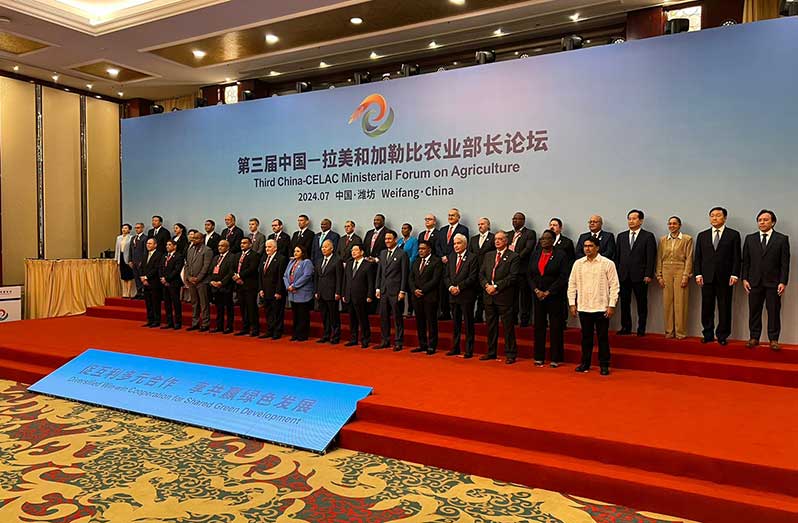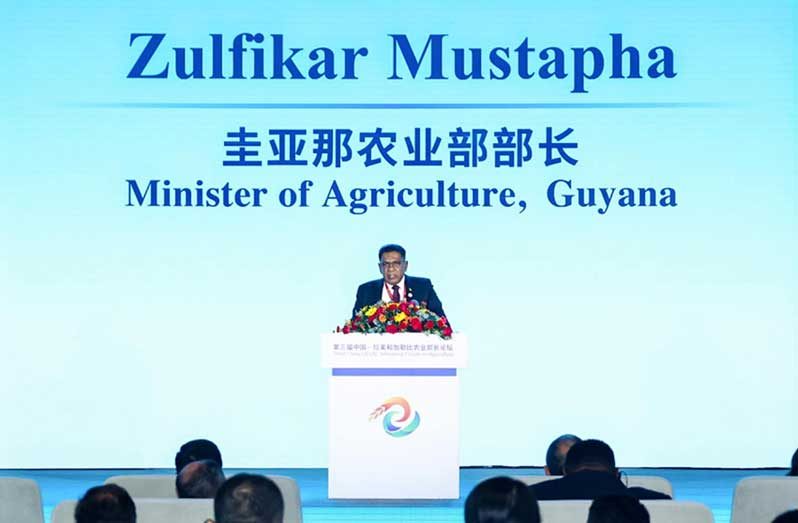–as Guyana, China enhance agricultural trade relations
–Two nations actively exploring development, innovative projects to enhance sector’s productivity, sustainability – Agriculture Minister says
By Naomi Parris
THE enhancement of agricultural trade relations between Guyana and China is being pursued through the active exploration of development and innovative projects within the sector.
This is according to Guyana’s Agriculture Minister Zulfikar Mustapha, who, during his address at the Thematic Session on Agricultural Economic and Trade of the Third China-CELAC Ministerial Forum on Agriculture in Weifang City, Shandong Province, China on Wednesday, said collaboration is being perused, particularly with the private sector.
“Towards improved trade relations and enhanced cooperation in agriculture and food security, Guyana has engaged in regional and international bilateral cooperations with several countries, including China,” Mustapha said.
Mustapha highlighted that the two nations have shared ‘deepening’ economic ties over the years, with bilaterial trade increasing from US$180 million in 2012 to US$1.23 billion in 2023, thus making Guyana one of the Asian country’s largest trade partners.
“Currently, Guyana mainly exports crude oil, aquatic products, sugar, timber and rum to China, while China ships construction machinery, motorcycles, manufacturing equipment, steel, electronics, textiles, garments and household appliances to Guyana.”
Guyana is now looking to strengthen cooperation with China in the area of agriculture.
As such, Mustapha disclosed that the South American State is in full support of the Action Plan on Strengthening China-CELAC Agricultural Cooperation (2024-2028), which will provide mutual benefits and win-win results by increasing the volume of trade, and stimulating agricultural investment.
He further highlighted that the Government of Guyana’s agricultural policies are targetted at increasing domestic production as well as sustainable agro-processing capabilities, while working with the region to remove all historical barriers and impediments to intra-regional trade, and promoting, more widely, agribusiness and complete transformation of regional food systems.
According to Mustapha, focus is being placed on the diversification of the agriculture sector, and we are actively promoting new and emerging crops like corn, soybeans and high-value fruits, vegetables (cauliflower, broccoli, etc), black-eye, red beans and millet, which is now being cultivated.
‘BIG POTENTIAL’
“Guyana is actively exploring agricultural development projects with China, particularly in collaboration with the private sector,” Mustapha said.
Recently, the country engaged the Jiangsu Foreign Affairs Office and other Chinese agricultural stakeholders to highlight the potential for significant collaborative achievements.
“Recognising the strengths of China in agricultural innovation and development, there is, particularly, interest in the advancements made by Jiangsu Province, which currently has an extensive repository of breeding materials for rice, corn, and wheat,” Mustapha explained.
He believes there are ‘promising opportunities’ to enhance agricultural productivity and sustainability with Jiangsu Mingtian Seed Technology Co. Ltd., production of seeds, and establishment of joint ventures.
INDUSTRY INVESTMENTS
Further, Mustapha noted that Guyana’s agriculture sector is a hub for investments; opportunities, he explained, exist for further expansion, mechanisation, and the development of value-added coconut products for both local consumption and global markets.
“There is an untapped potential for the conversion of coconut waste into value-added products,” he said.
Additionally, the country will soon commence its trial cultivation for the production of industrial hemp; Guyana is a promising hub for sustainable hemp production.
The cocoa and coffee industry in Guyana also presents opportunities for value addition, processing, and export to international markets. With growing demand for specialty and organic cocoa and coffee products, Guyana is well positioned to capitalise on this lucrative market segment.
In the fisheries and aquaculture sector, Guyana’s abundant freshwater resources and strategic coastal location offer significant potential for the growth of the fisheries and aquaculture sectors.
“Investments in aquaculture facilities, fish and shrimp processing plants, and feed production units will enable us to tap into international markets, such as the prawn market in the U.S. which is US$4 billion dollars. Our target is to meet 25 per cent of the US aquaculture market by 2027,” Mustapha explained.
Similarly, the livestock sector in Guyana, encompassing poultry, pork, beef, dairy, and small ruminants, is another area that presents vast market opportunities, with projected growth in meat production to meet the increasing demand from the tourism sector coupled with the offshore oil sector.
Finally, he highlighted the growing prospects of the Agro-Process Industry.
“The production of value-added agro-processed products, such as dehydrated fruits, seasoning, spices, and sauces, holds immense potential for market penetration and revenue generation.”
He added: “Opportunity also exists to expand the types of packaging materials available to processors at an affordable price.”



.jpg)










